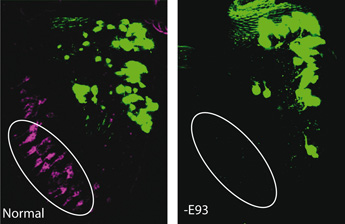Few genes control neuronal function
March 15, 2012

The magenta-colored structures are nerve cells that use odorant receptor 47b, which sense pheromones. Expression of this receptor is controlled by the transcription factor E93. When E93 is removed, the neurons lose their ability to fulfill their task of detecting pheromones, as evidenced by the deactivation of the fluorescent proteins (image to the right). The glowing, green cells, that use olfactory receptor 92a, are not affected because they are controlled by other transcription factors. (Credit: Linköping University)
Researchers at Linköping University in Sweden have taken a step closer to solving the mystery of how 100 billion neurons are created, each with specific duties.
“Knowledge about the mechanisms that diversify neurons and keep them diverse is necessary in order to cultivate and replace nerve cells in the future,” says Mattias Alenius, Assistant Professor of Neuroscience.
Alenius and his research team at the Department of Experimental and Clinical Medicine seek the answer to this pivotal question from a smaller perspective: the fruit fly’s olfactory system.
The humble fly’s olfactory system consists of 1200 olfactory neurons (humans have six million) divided into 34 groups. Each group responds to a particular set of odors, since all the neurons of the group use only one of the olfactory receptors present in the fly’s antennas. Together, the receptors provide the fly with the ability to distinguish between thousands of odors.
Alenius and his colleagues are the first to go through all of the fruit fly’s 753 gene regulatory genes, called transcription factors. They have identified a set of seven that, in different combinations, are required to create each of the 34 neuron groups in the antenna. A surprising finding is that most transcription factors perform two tasks simultaneously: they can activate odorant receptors’ expression; while at the same time turning off others in the same cell.
Alenius explains, “This is one of the many tricks that are useful to know for the future if you want to make and cultivate each of the many thousands of nerve cell groups that make up our brains.”
Ref.: S Jafari, et al., Combinatorial activation and repression by seven transcriptor factors specify Drosophila odorant receptor expression, PLoS Biology, 10:3, March 2012; [DOI:10.1371/journal.pbio.1001280]